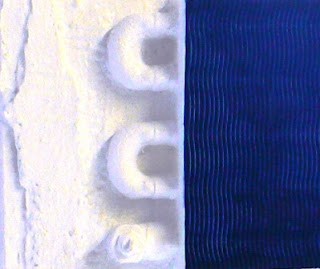Over the course of the past few months I have been closely monitoring the progress of 'Changing Spaces'. As well as regularly talking to Jonathan, I have made two studio visits and three sculpture site visits, all of which I have visually documented.
My three sculpture site visits have been very different. On the first visit I found a poplar tree trunk laying on the damp grass shedding its crumbly bark and soft wood along with a whole host of insect inhabitants.

By the time of the second visit it was obvious that the original plan for the sculpture (carving and inserting painted bricks) would have to be abandoned because of the unstable condition of the wood. When I arrived at the site I found Jonathan already well under way with Plan B, which involved removing the most rotten parts of the trunk, wrapping the whole thing in wire mesh and stabilising it with steel straps.

Today was my third site visit and although the sculpture is not yet finished, it is now upright and in its final position. Getting it there was a complicated operation and involved the assistance of several people and a mechanical digger to lift and move the sculpture, then lower it into position so that it could be placed upright in the hole dug manually by Jonathan last week.


The whole operation took about an hour and it would not have been possible without the actual physical and mechanical support of the team at the Waterworks Centre and the Lee Valley Park. At this stage it is very clear not only how much work has gone into creating the sculpture, but also just how collaborative the process has been.
I will do a final site visit to see the completed work shortly before the exhibition opens on June 16th.










